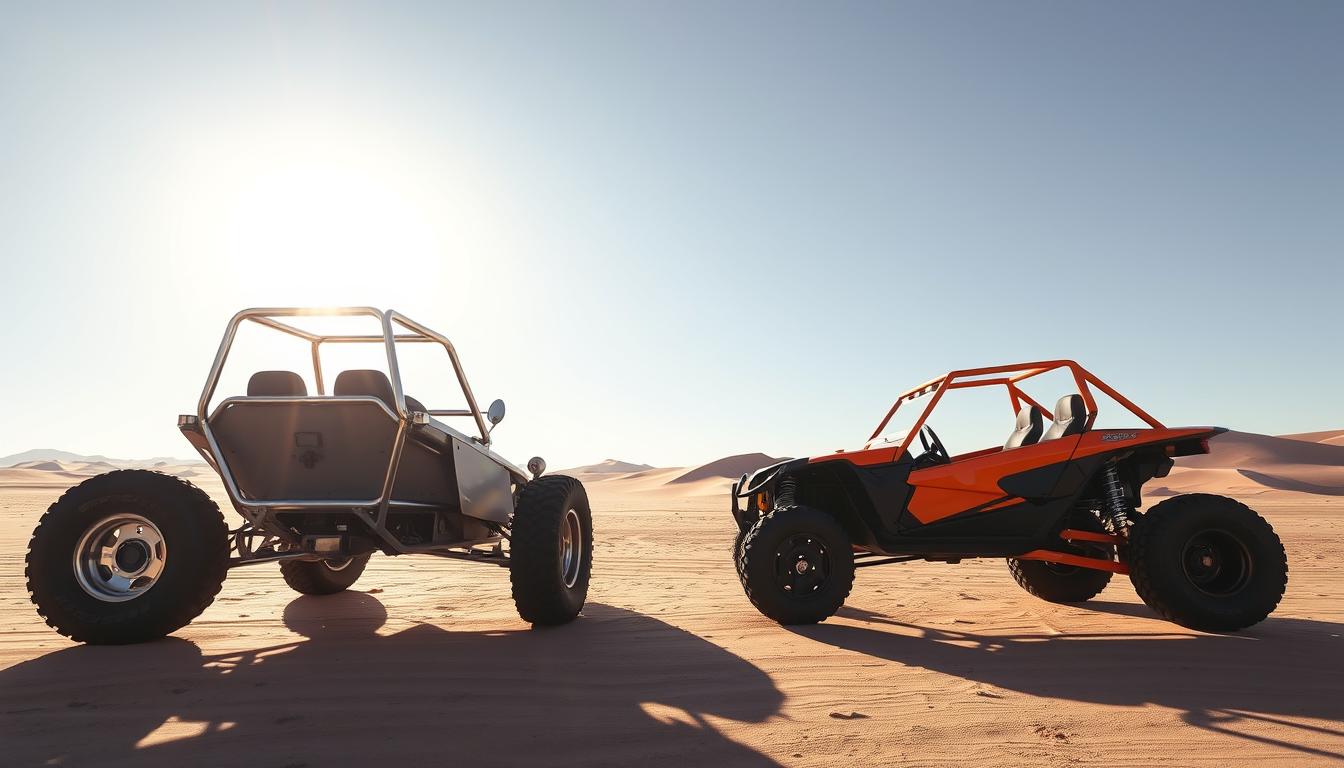
- 156 Views
- 6 Min Read
- (0) Comment
Imagine you’re standing at a desert’s edge, sunlight painting the dunes gold. There’s a thrill to riding here, with the wind whipping your hair. You might wonder about the difference between a sand rail and a dune buggy. Both are great for adventure, especially in places like the UAE. But knowing their differences can change how you enjoy off-roading. Let’s dive into what makes each vehicle unique and find out which one suits your adventurous heart.
Key Takeaways
- Understanding the core distinctions between sand rails and dune buggies enhances your off-road experience.
- Both vehicles are designed for sandy terrains but differ in performance and functionality.
- Recognizing specifications helps identify the right vehicle for your adventurous soul.
- Sand rails typically offer higher performance for racing and robust terrains.
- Dune buggies provide a more versatile approach to casual off-road fun.
Understanding Sand Rails
Sand rails are special off-road vehicles perfect for challenging terrains. They offer a thrilling drive. Knowing about sand rail features, specs, and uses is vital for those wanting to explore sandy areas.
Sand Rail Features
Sand rails’ features make them perform well and versatile. They have a light frame for better movement. The high ground clearance lets them tackle uneven grounds easily. Big tires help with excellent sand traction. Most sand rails come with strong engines for fast speeds and exciting acceleration.
Sand Rail Specifications
When looking at sand rail specs, there are several important factors. Engine sizes vary, usually between 1,600 cc to over 2,500 cc, based on the model. Their suspension systems are advanced, with long travel shocks for smoothing out rough terrains. They are about 5 to 6 feet wide and 10 to 12 feet long. This size gives plenty of space for people and safety gear.
| Feature | Specification |
|---|---|
| Engine Capacity | 1,600 cc – 2,500 cc |
| Width | 5 – 6 feet |
| Length | 10 – 12 feet |
| Suspension Type | Long travel shocks |
| Typical Weight | 1,000 – 1,800 lbs |
Common Uses of Sand Rails
Sand rails are mainly used for fun things like racing and off-roading in deserts or dunes. They are great for sand adventure due to their strong build. Besides fun, they are also used in farming or industrial work where the ground is rough.
Understanding Dune Buggies
Dune buggies provide excitement for those seeking adventures on sandy terrains. They offer a mix of performance and design. This discussion includes key details about their unique features, engine types, and uses.
Dune Buggy Characteristics
Dune buggies feature lightweight frames and open designs. This makes them agile and easy to maneuver on sand. They have room for several people, making group trips fun.
They are built to handle sand dunes and rough landscapes well. This is thanks to their high ground clearance and special tires. They are also made from strong materials to survive tough conditions.
Dune Buggy Engine Types
Dune buggies come with different engines, which affect their performance. You can find dune buggies with:
- Air-Cooled Engines: Classic models have these for reliable power without needing extra cooling parts.
- Water-Cooled Engines: Newer models use water-cooling to run better and last longer even when used a lot.
- Electric Engines: These are becoming more popular because they are quiet and better for the environment.
Common Uses of Dune Buggies
Dune buggies are used for more than just having fun driving. They are also used for:
- Beach Activities: They’re great for outings by the sea.
- Desert Tours: They’re often used for guided trips across deserts.
- Racing Events: Many people enjoy competing in races to show off their driving skills.
| Feature | Details |
|---|---|
| Weight | Lightweight frames enhance speed and agility. |
| Seating Capacity | Typically accommodates 2-4 passengers. |
| Engine Type | Varies from air-cooled to electric engines. |
| Common Uses | Recreational driving, racing, and tourism. |
What is the difference between a sand rail and a dune buggy?
If you love off-road adventures, it’s vital to know the difference between a sand rail and a dune buggy. Each one has a special role in off-road fun. This guide will show you the key differences to help you choose the right one.
Sand Rail vs Dune Buggy Differences
Sand rails are built for speed and agility, especially on sandy grounds. They’re usually lighter. This makes them quick and easy to steer. Dune buggies are more about comfort and can go on different terrains, not just sand. Even though both can be powerful, sand rails focus more on speed than on being comfy.
Off-Road Vehicles Comparison
Looking at off-road vehicles, think about what you want them for. Sand rails are great for fast rides on dunes, perfect for those who love excitement. Dune buggies blend speed with comfort, great for all kinds of desert trips. Choosing between them depends on if you want speed or comfort more on your off-road journeys.
Conclusion
Knowing the difference between a sand rail and a dune buggy is key. Each is designed for different needs and terrains. This makes choosing based on comfort, speed, and where you’ll ride very important.
Whether you like the speed of a sand rail or a dune buggy’s flexibility, understanding them makes your time in the sand better. Both are great for exploring, especially in places like the UAE deserts.
To choose the best for your adventure, learn about sand rails and dune buggies. This will help make your adventure unforgettable. It ensures you get the right ride for your goals.
If you’re eager to try off-road driving, check out Desert Buggy Rental Dubai. Call them at +971 52 440 9525 or visit their website for options like Dune Buggy Tours and Quad Biking. They’re open 24/7, ready for your adventure anytime.
FAQ
What is the primary difference between a sand rail and a dune buggy?
Sand rails are built for speed and quick moves, using light materials and strong engines. Dune buggies mix comfort and off-road skills. They’re better for fun rides and can carry passengers comfortably.
Are sand rails faster than dune buggies?
Yes, sand rails are usually faster. They have a light design and strong engines. This makes them great for fast races on sand, while dune buggies are more about comfy and varied use.
What engine types are commonly found in sand rails?
Sand rails mostly have high-power engines. This includes tweaked Volkswagen and Subaru engines. They provide lots of power for better speed and performance.
What are the typical uses of a sand rail?
Sand rails are mainly for racing in dunes and having fun off-road. They shine where speed and quick moves are key.
What characteristics define a dune buggy?
Dune buggies have large frames and comfy seats, sometimes with a cover. They aim to give a stable and fun ride for all.
What types of engines do dune buggies commonly use?
Dune buggies usually have smaller engines like Volkswagen’s. These engines are good for easy rides and exploring off-road places.
Which vehicle is better for beginners, a sand rail or a dune buggy?
Dune buggies are best for starters. Their design is easy to handle, stable, and comfy. This makes learning off-road driving simpler than in a fast-paced sand rail.
How do sand rails handle on different terrains compared to dune buggies?
Sand rails do best on sandy ground because they’re fast and agile. Dune buggies can go many places but might not be as quick in sand.
Can sand rails and dune buggies be modified?
Yes, both can be changed a lot to get more speed, comfort, or a new look. You can upgrade the engine, change the suspension, or tweak the looks to match what you want.
Categories
- Uncategorized (4)
- Desert Buggy Rental (1,254)
- Dune buggy (4)
- Quad Bike Rental (1)
- Desert safari (1)
- Hot air ballon (2)
- dirt bike (4)
Recent Post
Tags
Abu Dhabi theme parks Arabian desert beauty Best Shoes for Desert Safari Best time for Dubai Desert Safari Buggy car rental Dubai Buggy Rental Buggy Riding in Dubai Buggy Transportation Tips Buggy vs ATV comparison Can-Am dealers Dubai Child-Friendly Desert Safari Desert driving Desert driving attire Desert Safari outfit tips Desert safari with children Dubai adrenaline experience Dubai Buggy Rental Companies Dubai desert buggy rules Dubai Desert Experience Dubai dune bashing age limit Dubai dune tours Dubai waterways exploration Dune movie expenses Emirati culture immersion Exclusive Quad Biking Tours Exclusive sand cars Experience Dubai desert safari Explore Dubai in style Islamic influences License requirements for buggy driving Middle East Adventure Middle East Thrill Rides Pre-Existing Medical Conditions Protective gear for dune bashing Public transportation with a stroller Quad bike rentals in Dubai Sci-fi fandom Thrilling quad bike rides in Dubai Top-tier buggy models Top buggy excursions in Dubai Top quad bike rentals Trailer Options for Dune Buggies Travel discomfort UAE outdoor activities What to avoid wearing in Dubai



